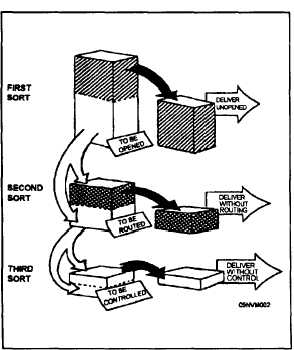| |
INCOMING MAIL ASHORE
In large headquarters organizations, and in
other naval shore activities, there is much less
personal mail.
However, the official mail
load may be quite large and require a large
mailroom with several persons opening and
sorting.
Incoming mail may be given three
sortings, at which every effort should be made
to separate out as much as possible for
delivery without further processing. Small
volume may
result in
sortings being
combined. Mail that passes on to the second
and third stage should do so only because it
requires the additional processing given at
each of these steps. The trick is to release it
at the earliest possible sort to avoid
unnecessary handling.
Figure 4-2 shows the three sortings and
action generated by each, and each is
explained more fully in following paragraphs.
Initial Sorting
On receipt, mail is given an initial sorting
that separates mail that can be delivered
Figure 4-2.-Sorting incoming mail
in a Navy mailroom.
without opening.
This is identified by
Attention To lines in the address, or knowing
by experience
that letters from certain
commands can be forwarded directly to a
specific department. The use of a sorting box
comes in handy for the initial sort. Letters to
be opened go in one place, and the others
can be placed directly into a space marked for
the receiving department.
Secondary Sorting
After the initial sorting the mail that was
not directly routed is opened. After opening,
it is again sorted. At this time, routine mail
(mail that presents no special problem) is
separated from mail that is nonroutine. The
sorter does not read further than necessary to
determine if a letter is routine, and when
satisfied that no special action is required, the
document is forwarded directly to the
appropriate department. During secondary
sorting, mail is checked for enclosures, but
mail should not be delayed awaiting missing
enclosures. Indicate that enclosures were not
received on the control slip (if used) or on the
document if it is forwarded directly to a
department.
Time-stamping, if required, is done at the
secondary
sorting.
Use
it
only
on
congressional mail, claims, or contracts. It is
not
r e c o m m e n d e d t h a t a l l m a i l be
time-stamped. This just adds another event
that could delay delivery.
Sorting for Control
Mail that remains for the third sorting
includes that for which the action person is
not readily apparent and mail that requires
control. The main purpose of this sorting is
to make sure mail requiring control receives
it.
Routing
Mail that does not require control is
routed without the use of a route slip or mail
4-5
|

